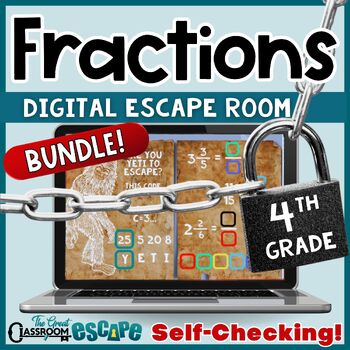4th Grade Fractions Activities Digital Escape Room Bundle Math Review Games
- Zip
- Google Apps™
- Easel Activity

Products in this Bundle (3)
Also included in
- The Great Classroom Escape's mega bundle of fourth grade math escape rooms address many of the 4th grade Common Core math standards through challenging and engaging worksheet alternatives. Escape rooms are a great way to review for end-of-year testing, provide extra practice, or encourage collaboratPrice $82.50Original Price $109.38Save $26.88
Description
If you're looking for 4th grade fractions worksheet alternatives to help students practice and review adding and subtracting fractions with like denominators, creating equivalent fractions, and working with decimals to the hundredths, then check out our digital escape room bundle covering fourth fraction standards. Three escape rooms are included, each offering a variety of standards-based practice. Best of all, these escape rooms are no prep, self-checking, and able to be completed by anyone with an internet-connected device. The online breakout process is automated by a Google Form™ (no e-mail or Google™ accounts are required).
Skills in Escape the Bakery
- Reduce fractions to their simplest terms
- Find the missing numerator or denominator to form equivalent fractions
- Compare fractions using <, >, and = symbols using such strategies as comparing with visual models, using benchmark fractions, or finding common denominators
- Find the lowest common denominator of two fractions (find the LCM of two numbers)
- Know fraction vocabulary such as the terms numerator and denominator
- Solve simple substitution ciphers
Skills in Free the Yeti
- Compare fractions with unlike denominators using <, >, and =
- Convert mixed numbers to improper fractions
- Add and subtract fractions with like denominators
- Add and subtract mixed numbers with like denominators with regrouping
- Multiply fractions by whole numbers
- Form equivalent fractions
- Solve word problems involving addition and subtraction of fractions and mixed numbers with like denominators
Skills in The Legend of the Lost Mine
- Form equivalent fractions with denominators of 10 and 100 in order to add to fractions together. 4.NF.C.5
- Rewrite fractions with denominators of 10 and 100 as decimals
- Rewrite decimals to the hundredths as fractions 4.NF.C.6
- Compare decimals to the hundredths using <, >, and = symbols 4.NF.C.7
- Recognize equivalent decimals and fractions with denominators of 10 and 100
- Read decimals and fractions on a number line (requires decomposing tenths to find a decimal number to the hundredths)
- Please see the preview for samples of all puzzles!
- *This escape room is one of our "Quick Escapes." Some students may complete this activity in 20 minutes, others will take closer to 45 minutes.
What's included in the PDFs?
- Quick start guide with link to each digital escape room
- Escape the Bakery & The Legend of the Lost Mine include Recording pages including place value blocks and number lines to help students work out the puzzles
- Escape the Bakery & The Legend of the Lost Mine include "tools" page with place value blocks, place value charts, and number lines for students to use to create visual models
- Optional link for Google Drive™ users to create a copy of the form to save to their own drives in order to view student results.
- Answer key & teacher tips
- Success signs to snap photos with after completing the activity (optional)
Digital Escape Room FAQ
- Do students need to have Gmail™ accounts? NO! Anyone with internet access and a tablet, computer, or even phone can complete the breakout.
- How long will this take? That is the hardest question as the answer varies depending on each classroom, student, or group. Many students with a firm grasp on decimal concepts will complete this escape room in under 30 minutes. You can allow 60 minutes to be safe. The form will only save data if students are signed into Google accounts, so if you are worried about your students not finishing on time, simply have them write their answers on scratch paper. They can then come back and quickly re-enter their answers and pick up where they left off. Some students with a firm grasp on the concepts covered in this escape room will be able to complete the puzzles very quickly (20-30 minutes), others will take longer.
- Can this be used for remote learning? Yes! This product is designed to be able to be completed completely online and can be done in-person, for distance learning, or hybrid models. Students will need a device and internet connection.
- Will students have to search the web to figure out the puzzles? NO! All of the information needed will be provided in the Google Form™. The math in this activity is all standards-based.






